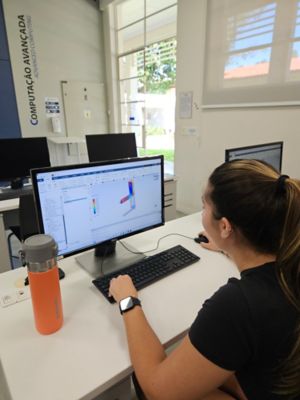The Design - LES Simulation of a Fluid Vortex Emulating Black Holes | ANSYS Fluent
Large-eddy simulation (LES) is a mathematical model for turbulence used in computational fluid dynamics. It was initially proposed in 1963 by Joseph Smagorinsky to simulate atmospheric air currents and was first explored by Deardorff (1970). LES is currently applied in a wide variety of engineering applications, including combustion, acoustics, and simulations of the atmospheric boundary layer.
The simulation of turbulent flows by numerically solving the Navier–Stokes equations requires resolving a very wide range of time and length scales, all of which affect the flow field. Such a resolution can be achieved with direct numerical simulation (DNS), but DNS is computationally expensive, and its cost prohibits simulation of practical engineering systems with complex geometry or flow configurations, such as turbulent jets, pumps, vehicles, and landing gear.
The principal idea behind LES is to reduce the computational cost by ignoring the smallest length scales, which are the most computationally expensive to resolve, via low-pass filtering of the Navier–Stokes equations. Such low-pass filtering, which can be viewed as a time- and spatial-averaging, effectively remove small-scale information from the numerical solution. This information is not irrelevant, however, and its effect on the flow field must be modeled as a task that is an active area of research for problems in which small scales can play an important role, such as near-wall flows, reacting flows, and multiphase flows.
In this analysis, it has been tried to simulate and analyze LES Simulation of a Fluid Vortex Emulating Black Holes using Ansys Fluent software.
Geometry & Grid
The geometry required for this analysis was generated by Ansys Design Modeler software. The meshing required for this analysis was also generated by Ansys Meshing software. The mesh type used in this analysis is unstructured. The total number of volume properties for geometry is 1,8655e+005 mm³.
Model
In this analysis, the volume of the fluid multiphase model & Large-Eddy simulation (LES), WALE viscous model is used to check the fluid flow.
Boundary Condition
The flow of primary input design modeler geometry for this analysis is considered as velocity magnitude and is 1 (m/s). The flow output range is also considered as a pressure outlet for the flow output region and gauge pressure is equal to 0 (pascal). The inner wall is also considered a Stationary Wall.
Discretization of Equations
According to the type of flow, the SIMPLE algorithm is used to discretize the Pressure-Velocity Coupling of the solution method. The momentum equation has been discretized in the Bounded Central Differencing.
The results are presented as volume fraction as well as volume rendering.
The Design Services
We also accept all CFD projects using ANSYS Fluent and ANSYS CFX. Our digital workshop has gathered experts in different engineering fields so as to ensure the quality of CFD simulations. One of our objectives is to boost the use of powerful computational fluid dynamics methods and also teach the engineers and those who seek professional knowledge in CFD.
ِDoing CFD projects will be faster and easier with our services. Call us for training in CFD applications and CFD packages. Our professional CFD engineers offer you professional consultation and technical supports for your academic CFD projects and industrial CFD projects. We offer you CFD learning, CFD project by ANSYS Fluent and ANSYS CFX, CFD consulting by ANSYS Fluent and ANSYS CFX, CFD service by ANSYS Fluent and ANSYS CFX, ANSYS Fluent and ANSYS CFX project, ANSYS Fluent and ANSYS CFX thesis, ANSYS Fluent and ANSYS CFX simulation, ANSYS Fluent and ANSYS CFX paper regeneration, ANSYS Fluent and ANSYS CFX academic project, ANSYS Fluent and ANSYS CFX industrial project, ANSYS Fluent, and ANSYS CFX research project, and low CFD Price. Moreover, we have years of experience in coordinating CFD projects. Therefore, we are ready to perform your CFD simulations in different engineering fields.




No comments:
Post a Comment